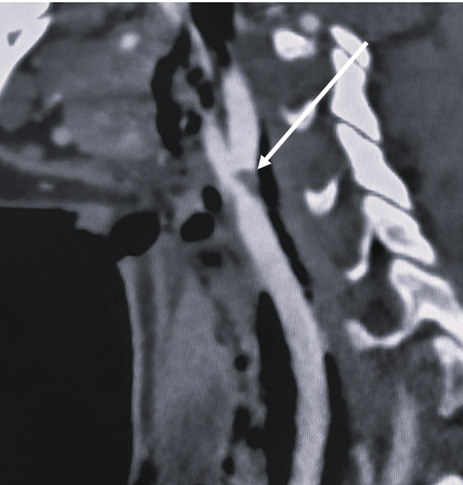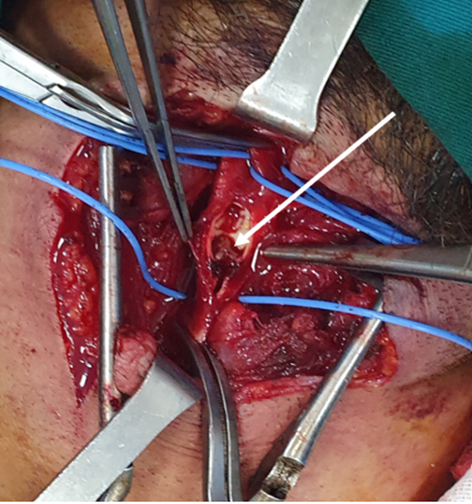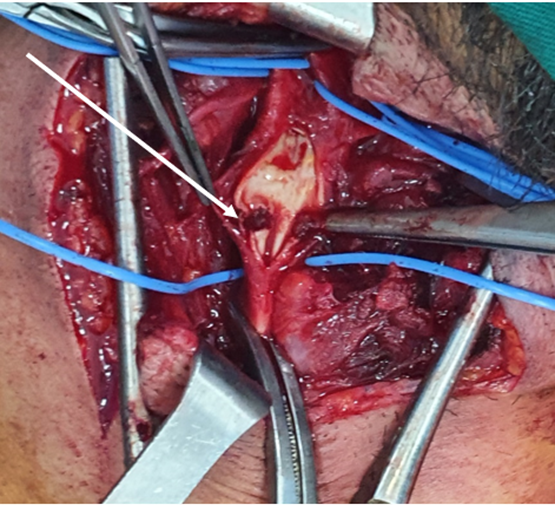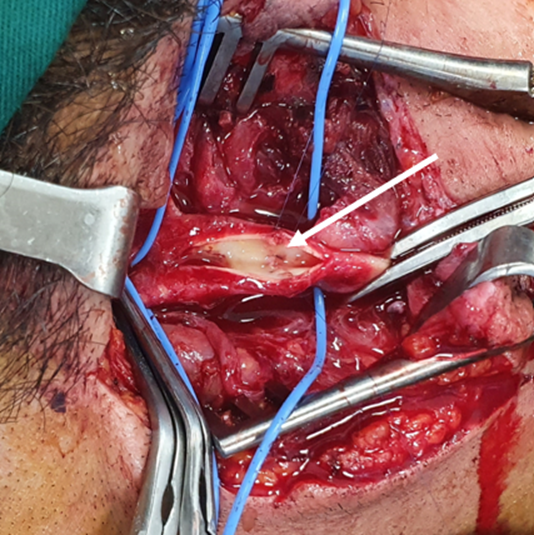S El Hadhri1*, M Gueldich1, S.Kallel2, A Zaidi2, D Ayman1, BJ Hela1, I Frikha1
1Department of Cardiovascular and Thoracic Surgery, Habib Bourguiba Hospital, Alfirdaws road, 3029, Sfax -Tunisia
2Department of Oro-rhino-laryngology, Habib Bourguiba Hospital, Alfirdaws road, 3029, Sfax -Tunisia
*Corresponding Author: S El Hadhri, Department of Cardiovascular and Thoracic Surgery, Habib Bourguiba Hospital, Alfirdaws road, 3029, Sfax -Tunisia; Email: [email protected]
Published On: 19-04-2022
Copyright© 2022 by Hadhri ELS, et al. All rights reserved. This is an open access article distributed under the terms of the Creative Commons Attribution License, which permits unrestricted use, distribution and reproduction in any medium, provided the original author and source are credited.
Abstract
Introduction: Blunt carotid artery dissection is relatively rare and different from spontaneous dissections. Ischemic stroke is the main complication with high morbidity and mortality rates.
Case report: We report the case of a 32 years old man who had a polytraumatic injury and was admitted in our emergency unit. Injuries of the head and a dissection of the right internal carotid artery were identified on CT. The patient was then successfully management and had surgical repair of right internal carotid artery and head injuries.
Conclusion: Management of blunt carotid dissection is challenging; in fact, no guidelines are actually available. Treatment should be conducted quickly after trauma and could be conservative, endovascular or open.
Keywords
Trauma; Polytraumatic Injury; Floating Thrombus; Longitudinal Arteriotomy
Introduction
Cervical artery dissection following head and neck trauma is an uncommon but life-threatening entity that accounts for a high rate of ischemic strokes in young patients under the age of 45 years [1-4].
The most commonly involved arteries are the internal carotid and vertebral arteries; injuries and dissections may take place after direct or indirect trauma to the head and neck [5,6].
These injuries are responsible for a morbidity and mortality rate ranging between 23 to 28%. Nevertheless, almost 48 % of survivors are facing significant neurological complications [7,8]. However, if unrecognized or untreated, neurological complications may increase to reach 60 % [9].
We report the case of a 32 years old man with a successful surgical management of a traumatic dissection of the right internal carotid artery.
Case Report
A 32 years old male patient had a poly-traumatic injury in a motorcycle accident, and was admitted in the emergency unit. The physical exam revealed the presence of a right latero-cervical wound with venous bleeding managed with compression. The patient was conscious and stable, and the neurological exam was perfectly normal. The body scan revealed a right internal carotid dissection with the presence of a floating thrombus (Fig. 1) with no cerebral injuries.

Figure 1: Longitudinal CT slice showing internal carotid artery dissection and floating thrombus.
There were also signs of arytenoid subluxation and injury signs of the right piriform sinus and cricothyroid membrane.
Considering the high risk of neurological complications and stroke due to thrombus migration’s risk, the patient received a bolus of heparin and was conducted directly to the operating room. The first operating part was handled by cardiovascular team, at first sight the right carotid vessels were intact and had no signs of appearing injury which suggested that the dissection was due to blunt trauma.
We controlled the right carotid bifurcation and we administrated a second bolus of heparin (0.5 mg/kg) then we clamped the three carotid vessels beginning with the internal carotid artery. A longitudinal arteriotomy was performed (Fig. 2) and revealed the presence of the thrombus (Fig. 3) and a transversal intimal tear inside the right internal carotid artery.

Figure 2: Longitudinal arteriotomy revealing the intraluminal thrombus.

Figure 3: Intimal tear revealed after cleaning the carotid lumen.
We began with extracting the thrombus and cleaning the internal carotid lumen, then we sutured the intimal tear with 7/0 prolene (Fig. 4). The arteriotomy was closed after performing the purge.

Figure 4: Intimal tear sutured with Prolene 7/0.
The second operating part was managed by otorhinolaryngology team, they reduced the arytenoid subluxation and sutured the right piriform sinus and cricothyroid membrane.
The patient was kept intubated for two days in order to avoid cervical oedema and there was extubated in the third day. The short-term outcomes were simple without neurological complications and the patient was discharged at day 10 then reviewed after 1 month in perfect health.
Discussion
Blunt carotid trauma is observed in 1%- 2.6% of blunt injury cases [10]. Moreover, it has been associated with an elevated stroke rate (up to 60%) and mortality rate (19%-43%). Many patients remain asymptomatic until symptoms of cerebrovascular ischemia take place. Symptoms usually occur after a mean of 12.5 hours in survivors and 19.5 hours in non-survivors [11].
Motor vehicle accidents are the major cause, and are responsible for more than 50% of carotid artery dissections [12].
The principal mechanism of carotid artery injury consists on hyperextension and contra-lateral rotation of the head and neck, as a result, the internal carotid artery is stretched across the lateral processes of the cervical vertebra. Another crucial mechanism is the direct pressure on the neck, e.g. by a seatbelt [13]. The most frequent location for post traumatic carotid injury is located just beyond the bulb. This may be explained by wall stress incensement on the intima of this arterial segment due to head movements [14,15].
The pathological background consists on intimal disruption that causes luminal narrowing and even occlusion in some cases due to the collapse of the false lumen against the true lumen. The exposed sub-endothelial collagen acts as a thrombogenic factor and starts platelet aggregation and thrombus formation which can lead to embolization. This is the main explanation for stroke following blunt carotid trauma [16].
Although most patients are asymptomatic and have no signs of neurological deficit on diagnosis, it is well established that a latent period exists and ranging from hours to days during which neurological deficits may take place in the initially asymptomatic patient. This symptomatology is variable and depends on the injured artery, injury site and grade. The average time for a stroke’s development is ranged between 12 and 75 hours post trauma, but may take several hours to weeks in some cases [17-19].
There are actually no guidelines for treating this specific entity but some studies have focused on the subject and it appears that asymptomatic patients can be treated conservatively with medical management and close imaging observation [20].
These patients achieve anatomic and symptomatic recovery in the majority of cases, with low rates of recurrence or complications over long-term evolution [21]. Anticoagulation and anti-platelet agents have shown similar efficacy in reducing neurological events without increasing the risk for stroke [18,20,21]. However, frequent presence of other traumatic injuries demands a more interdisciplinary approach to evaluate risk and profit for conservative management.
However, endovascular treatment has become more popular lately, and it is described as an easier therapeutic option even for traumatic cases [1]. In a recent meta-analysis, endovascular treatment of carotid dissections, has shown satisfying technical success, low recurrent rates and one-year follow-up results [22]. Authors suggested a list of criteria for stenting:
- Recurrence of symptoms despite medical therapy
- Hemodynamic hypoperfusion
- Expanding or symptomatic pseudoaneurysm
- Contraindication to anticoagulation due to intracranial or systemic hemorrhage. Another study published by Spanos, et al., including 193 patients showed that patients who were managed endovascularly for traumatic carotid artery dissection encountered low short-term morbidity and mortality rates, respectively 6% and 1.2%, as well as low re-intervention rate during long-term follow-up [23]
However, endovascular treatment with stent placement requires antiplatelet therapy to avoid embolic complications or stent thrombosis which is not always possible due to contraindications to antithrombotic drugs in patients with severe associated injuries. Seth, et al., suggested avoiding stent placement in patients who cannot receive pre- and postprocedural antiplatelet drugs [10].
On the other hand, multiple surgical techniques are available. Procedures vary from extracranial-intracranial bypass, thromboendarterectomy to intimal repair. The need for surgery is determined by the thrombogenicity of the injured carotid segment, the state of collateral suppliance to the brain, presence of an expanding hematoma or worsening neurological deficit despite optimal anticoagulation [24]. It’s essentially indicated for patients with no neurologic deficits or mild deficits and it is usually performed for traumatic carotid occlusive lesions [25,26].
Surgical repair of the damaged vessel is not only necessary to improve cerebral flow, but also to prevent complete thrombosis of the carotid arteries and embolic events.
A study conducted by Yamada, et al., included 52 patients and showed that better outcomes were obtained with surgery [27]. In cases treated with surgery with the most complication’s rate, surgery was performed many hours or days after the injury, however successful surgery cases were directly performed immediately after the clinical presentation.
In our case, surgical management was urgently indicated due to the presence of a floating thrombus inside the internal carotid artery that made the endovascular treatment very risky and stroke’s advent imminent.
Conclusion
Blunt carotid arteries injuries are life-threatening conditions that require quick diagnosis and management.
In the majority of cases, a variable latent period of time exists between the time of injury and symptoms.
There are actually no guidelines for treating blunt carotid injuries and the treatment can be conservative with antithrombotic agents, or invasive with endovascular and surgical approach.
Conflict of Interest
It is stated that there are no conflicts of interest.
References
- Patel RR, Adam R, Maldjian C, Lincoln CM, Yuen A, Arneja A. Cervical carotid artery dissection: current review of diagnosis and treatment. Cardiol Rev. 2012;20(3):145‑52.
- Mohan IV. Current optimal assessment and management of carotid and vertebral spontaneous and traumatic dissection. Angiol. 2014;65(4):274‑83.
- Fink ME, Callahan L, Fibel K, Ramsay J, Kelly AB. Internal carotid artery dissection after indirect blunt cervical trauma in an ice hockey goaltender. Am J Orthop. 2017;46(3):E139-43.
- Bergquist BJ, Boone SC, Whaley RA. Traumatic dissection of the internal carotid artery treated by ECIC anastomosis. Stroke. 1981;12(1):73-6.
- Kalantzis G, Georgalas I, Chang BYP, Ong C, El-Hindy N. An unusual case of traumatic internal carotid artery dissection during snowboarding. J Sports Sci Med. 2014;13(2):451‑3.
- Lu A, Shen P, Lee P, Dahlin B, Waldau B, Nidecker AE, et al. CrossFit-related cervical internal carotid artery dissection. Emerg Radiol. 2015;22(4):449-52.
- Biffl WL, Moore EE, Ryu RK, Offner PJ, Novak Z, Coldwell DM, et al. The unrecognized epidemic of blunt carotid arterial injuries: early diagnosis improves neurologic outcome. Ann Surg. 1998;228(4):462.
- Bajkó Z, Bălaşa R, Moţăţăianu A, Bărcuţean L, Stoian A, Stirbu N, et al. Malignant middle cerebral artery infarction secondary to traumatic bilateral internal carotid artery dissection. A case report. J Crit Care Med. 2016;2(3):135‑41.
- Jacobson LE, Ziemba-Davis M, Herrera AJ. The limitations of using risk factors to screen for blunt cerebrovascular injuries: the harder you look, the more you find. World J Emerg Surg. 2015;10(1):46.
- Seth R, Obuchowski AM, Zoarski GH. Endovascular repair of traumatic cervical internal carotid artery injuries: a safe and effective treatment option. Am J Neuroradiol. 2013;34(6):1219‑26.
- Lee TS, Ducic Y, Gordin E, Stroman D. Management of carotid artery trauma. Craniomaxillofacial Trauma Reconstr. 2014;7(3):175‑89.
- Cogbill TH, Moore EE, Meissner M, Fischer RP, Hoyt DB, Morris JA, et al. The spectrum of blunt injury to the carotid artery: a multicenter perspective. J Trauma Inj Infect Crit Care. 1994;37(3):473‑9.
- Zelenock GB. Extracranial internal carotid artery dissections: noniatrogenic traumatic lesions. Arch Surg. 1982;117(4):425.
- Callaghan FM, Luechinger R, Kurtcuoglu V, Sarikaya H, Poulikakos D, Baumgartner RW. Wall stress of the cervical carotid artery in patients with carotid dissection: a case-control study. Am J Physiol-Heart Circ Physiol. 2011;300(4):H1451‑8.
- Caso V, Paciaroni M, Bogousslavsky J. Environmental factors and cervical artery dissection. Handbook on cerebral artery dissection. 2005;20:44-53.
- Foreman PM, Harrigan MR. Blunt traumatic extracranial cerebrovascular injury and ischemic stroke. Cerebrovasc Dis Extra. 2017;7(1):72‑83.
- Fabian TC, George SM, Croce MA, Mangiante EC, Voeller GR, Kudsk KA. Carotid artery trauma: management based on mechanism of injury. J Trauma Inj Infect Crit Care. 1990;30(8):953‑63.
- Cothren CC. Treatment for blunt cerebrovascular injuries: equivalence of anticoagulation and antiplatelet agents. Arch Surg. 2009;144(7):685.
- Ahmad HA, Gerraty RP, Davis SM, Cameron PA. Cervicocerebral artery dissections. Emerg Med J. 1999;16(6):422‑4.
- Cothren CC. Anticoagulation is the gold standard therapy for blunt carotid injuries to reduce stroke rate. Arch Surg. 2004;139(5):540.
- Rao AS, Makaroun MS, Marone LK, Cho JS, Rhee R, Chaer RA. Long-term outcomes of internal carotid artery dissection. J Vasc Surg. 2011;54(2):370‑5.
- Xianjun H, Zhiming Z. A systematic review of endovascular management of internal carotid artery dissections. Interv Neurol. 2012;1(3‑4):164‑70.
- Spanos K, Karathanos C, Stamoulis K, Giannoukas AD. Endovascular treatment of traumatic internal carotid artery pseudoaneurysm. Injury. 2016;47(2):307‑12.
- Singh RR, Barry MC, Ireland A, Bouchier Hayes D. Current diagnosis and management of blunt internal carotid artery injury. Eur J Vasc Endovasc Surg. 2004;27(6):577‑84.
- Perry MO, Snyder WH, Thal ER. Carotid artery injuries caused by blunt trauma. Ann Surg. 1980;192(1):74‑7.
- Little JM, Vanderfield GK, May J, Lamond S. Traumatic thrombosis of the internal carotid artery. The Lancet. 1969;294(7627):926‑30.
- Yamada S, Kindt GW, Youmans JR. Carotid artery occlusion due to nonpenetrating injury. J Trauma Inj Infect Crit Care. 1967;7(3):333‑42.
Article Type
Case Report
Publication History
Received On: 28-03-2022
Accepted On: 11-04-2022
Published On: 19-04-2022
Copyright© 2022 by Hadhri ELS, et al. All rights reserved. This is an open access article distributed under the terms of the Creative Commons Attribution License, which permits unrestricted use, distribution, and reproduction in any medium, provided the original author and source are credited.
Citation: Hadhri ELS, et al. Successful Surgical Management of a Traumatic Dissection of Internal Carotid Artery. J Surg Res Prac. 2022;3(1):1-8.

Figure 1: Longitudinal CT slice showing internal carotid artery dissection and floating thrombus.

Figure 2: Longitudinal arteriotomy revealing the intraluminal thrombus.

Figure 3: Intimal tear revealed after cleaning the carotid lumen.

Figure 4: Intimal tear sutured with Prolene 7/0.


